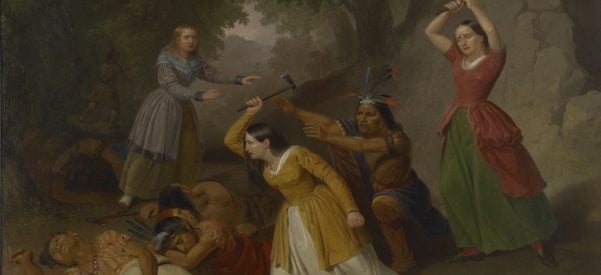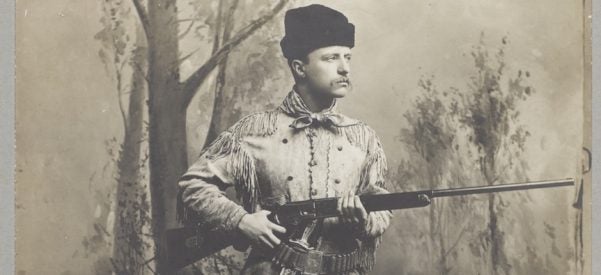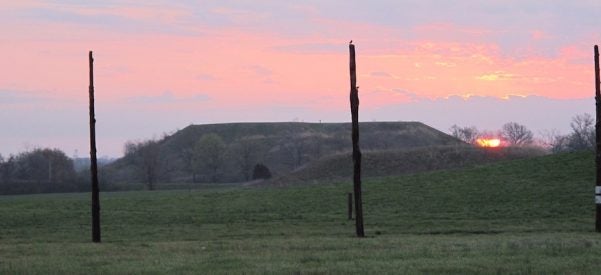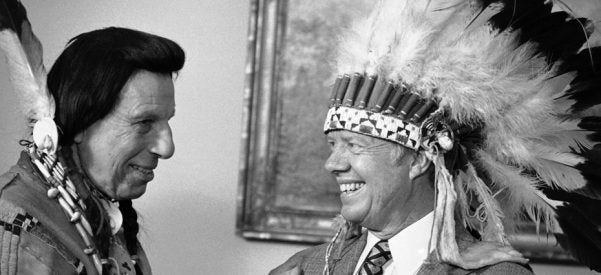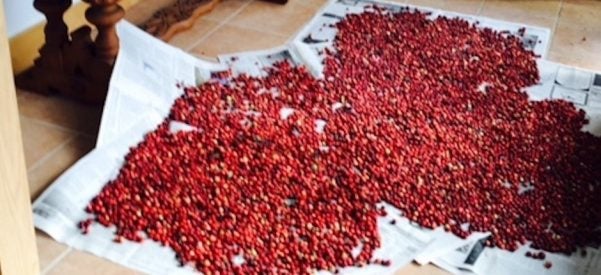Explore
: Native American History
Hannah Duston Was Used as a National Symbol of Innocence, Valor, and Patriotism to Justify Westward Expansion
By Barbara Cutter
April 9, 2018
On a small island north of Concord, New Hampshire, stands a 25-foot-tall granite statue of Hannah Duston, an English colonist taken captive by Native Americans in 1697, during King William’s War. Erected in 1874, the statue bears close resemblance to contemporary depictions of Columbia, the popular “goddess of liberty” and female allegorical symbol of the nation, except for what she holds in her hands: in one, a tomahawk; in the other, a fistful of human scalps.
Though she’s all but forgotten …
Read More >
Even as White Frontiersmen Battled Native Americans, They Adopted Their Symbols of Masculinity
By Jimmy L. Bryan Jr.
March 12, 2018
In recent years, fashion leaders have provoked criticism for incorporating Native American imagery in their designs. In 2011, Urban Outfitters introduced a line of Navajo-themed clothing and accessories that included the “Vintage Woolrich Navajo Jacket,” the “Ecote Navajo Wool Tote Bag,” and the “Navajo Hipster Panty.”
The Navajo Nation sued the company for copyright infringement of its name and, after a five-year court battle, the two sides settled. At a 2012 Victoria’s Secret fashion show in New York, model Karlie …
Read More >
Pioneers and Early Archeologists Preferred to Credit Distant Civilizations, Not Native Americans, With Building These Monumental Cities
By Sarah E. Baires
February 22, 2018
Around 1100 or 1200 A.D., the largest city north of Mexico was Cahokia, sitting in what is now southern Illinois, across the Mississippi River from St. Louis. Built around 1050 A.D. and occupied through 1400 A.D., Cahokia had a peak population of between 25,000 and 50,000 people. Now a UNESCO World Heritage Site, Cahokia was composed of three boroughs (Cahokia, East St. Louis, and St. Louis) connected to each other via waterways and walking trails that extended across the Mississippi …
Read More >
Behind the '70s Anti-Pollution Icon Was an Italian-American Actor—and the Beverage Industry
By Finis Dunaway
November 9, 2017
It’s probably the most famous tear in American history: Iron Eyes Cody, an actor in Native American garb, paddles a birch bark canoe on water that seems, at first, tranquil and pristine, but that becomes increasingly polluted along his journey. He pulls his boat ashore and walks toward a bustling freeway. As the lone Indian ponders the polluted landscape, a passenger hurls a paper bag out a car window. The bag bursts on the ground, scattering fast-food wrappers all over …
Read More >
For as Long as Anyone Knows, the Wampanoag Have Connected to Their History Through the Fruit and the Bogs Where It Grows
By Beverly Wright
October 9, 2017
Many know the place I live, an island off the southern coast of Massachusetts, as Martha’s Vineyard, a vacation spot for celebrities including Presidents Clinton and Obama. But those of us in the Aquinnah Wampanoag Tribe know it as Noepe, our home for at least 13,000 years. Though the whole island used to be our traditional homelands, today, our homelands form the westernmost part of the island, centered on the Town of Aquinnah and including many cranberry bogs. It’s there—on …
Read More >


